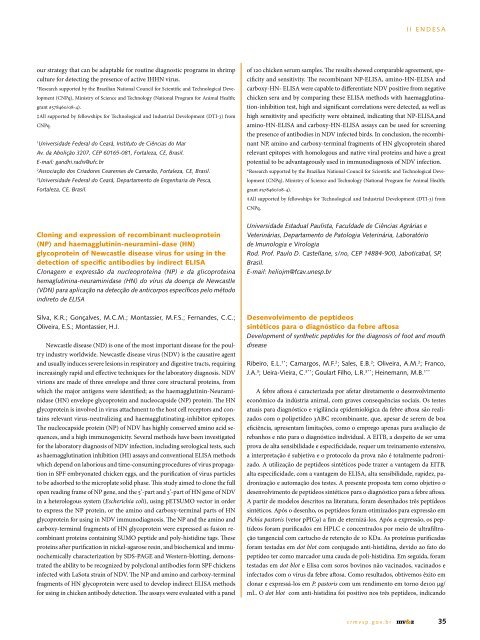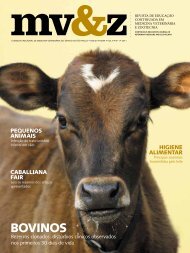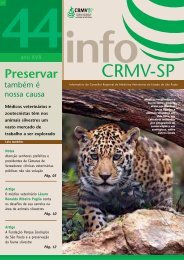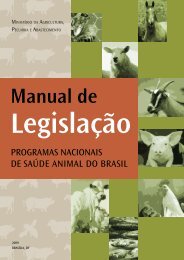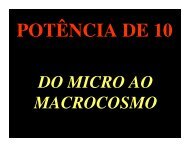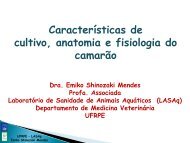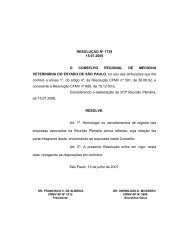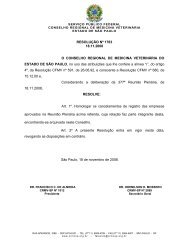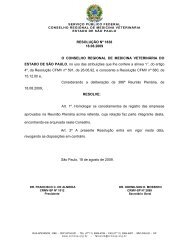Create successful ePaper yourself
Turn your PDF publications into a flip-book with our unique Google optimized e-Paper software.
I I e n d e s aour strategy that can be adaptable for routine diagnostic programs in shrimpculture for detecting the presence of active IHHN virus.*Research supported by the Brazilian National Council for Scientific and Technological Development(CNPq), Ministry of Science and Technology (National Program for Animal Health;grant #578460/08-4).‡All supported by fellowships for Technological and Industrial Development (DTI-3) fromCNPq.1Universidade Federal do Ceará, Instituto de Ciências do MarAv. da Abolição 3207, CEP 60165-081, Fortaleza, CE, Brasil.E-mail: gandhi.radis@ufc.br2Associação dos Criadores Cearenses de Camarão, Fortaleza, CE, Brasil.3Universidade Federal do Ceará, Departamento de Engenharia de Pesca,Fortaleza, CE, Brasil.Cloning and expression of recombinant nucleoprotein(NP) and haemagglutinin-neuramini-dase (HN)glycoprotein of Newcastle disease virus for using in thedetection of specific antibodies by indirect elisaClonagem e expressão da nucleoproteína (NP) e da glicoproteinahemaglutinina-neuraminidase (HN) do vírus da doença de Newcastle(VDN) para aplicação na detecção de anticorpos específicos pelo métodoindireto de ELISASilva, K.R.; Gonçalves, M.C.M.; Montassier, M.F.S.; Fernandes, C.C.;Oliveira, E.S.; Montassier, H.J.Newcastle disease (ND) is one of the most important disease for the poultryindustry worldwide. Newcastle disease virus (NDV) is the causative agentand usually induces severe lesions in respiratory and digestive tracts, requiringincreasingly rapid and effective techniques for the laboratory diagnosis. NDVvirions are made of three envelope and three core structural proteins, fromwhich the major antigens were identified; as the haemagglutinin-Neuraminidase(HN) envelope glycoprotein and nucleocapside (NP) protein. The HNglycoprotein is involved in virus attachment to the host cell receptors and containsrelevant virus-neutralizing and haemagglutinating-inhibitor epitopes.The nucleocapside protein (NP) of NDV has highly conserved amino acid sequences,and a high immunogenicity. Several methods have been investigatedfor the laboratory diagnosis of NDV infection, including serological tests, suchas haemagglutination inhibition (HI) assays and conventional ELISA methodswhich depend on laborious and time-consuming procedures of virus propagationin SPF embryonated chicken eggs, and the purification of virus particlesto be adsorbed to the microplate solid phase. This study aimed to clone the fullopen reading frame of NP gene, and the 5’-part and 3’-part of HN gene of NDVin a heterologous system (Escherichia coli), using pETSUMO vector in orderto express the NP protein, or the amino and carboxy-terminal parts of HNglycoprotein for using in NDV immunodiagnosis. The NP and the amino andcarboxy-terminal fragments of HN glycoprotein were expressed as fusion recombinantproteins containing SUMO peptide and poly-histidine tags. Theseproteins after purification in nickel-agarose resin, and biochemical and immunochemicallycharacterization by SDS-PAGE and Western-blotting, demonstratedthe ability to be recognized by polyclonal antibodies form SPF chickensinfected with LaSota strain of NDV. The NP and amino and carboxy-terminalfragments of HN glycoprotein were used to develop indirect ELISA methodsfor using in chicken antibody detection. The assays were evaluated with a panelof 120 chicken serum samples. The results showed comparable agreement, specificityand sensitivity. The recombinant NP-ELISA, amino-HN-ELISA andcarboxy-HN- ELISA were capable to differentiate NDV positive from negativechicken sera and by comparing these ELISA methods with haemagglutination-inhibitiontest, high and significant correlations were detected, as well ashigh sensitivity and specificity were obtained, indicating that NP-ELISA,andamino-HN-ELISA and carboxy-HN-ELISA assays can be used for screeningthe presence of antibodies in NDV infected birds. In conclusion, the recombinantNP, amino and carboxy-terminal fragments of HN glycoprotein sharedrelevant epitopes with homologous and native viral proteins and have a greatpotential to be advantageously used in immunodiagnosis of NDV infection.*Research supported by the Brazilian National Council for Scientific and Technological Development(CNPq), Ministry of Science and Technology (National Program for Animal Health;grant #578460/08-4).‡All supported by fellowships for Technological and Industrial Development (DTI-3) fromCNPq.Universidade Estadual Paulista, Faculdade de Ciências Agrárias eVeterinárias, Departamento de Patologia Veterinária, Laboratóriode Imunologia e VirologiaRod. Prof. Paulo D. Castellane, s/no, CEP 14884-900, Jaboticabal, SP,Brasil.E-mail: heliojm@fcav.unesp.brDesenvolvimento de peptídeossintéticos para o diagnóstico da febre aftosaDevelopment of synthetic peptides for the diagnosis of foot and mouthdiseaseRibeiro, E.L. 1* ; Camargos, M.F. 2 ; Sales, E.B. 2 ; Oliveira, A.M. 2 ; Franco,J.A. 3 ; Ueira-Vieira, C. 3** ; Goulart Filho, L.R. 3** ; Heinemann, M.B. 1**A febre aftosa é caracterizada por afetar diretamente o desenvolvimentoeconômico da indústria animal, com graves consequências sociais. Os testesatuais para diagnóstico e vigilância epidemiológica da febre aftosa são realizadoscom o polipetídeo 3ABC recombinante, que, apesar de serem de boaeficiência, apresentam limitações, como o emprego apenas para avaliação derebanhos e não para o diagnóstico individual. A EITB, a despeito de ser umaprova de alta sensibilidade e especificidade, requer um treinamento extensivo,a interpretação é subjetiva e o protocolo da prova não é totalmente padronizado.A utilização de peptídeos sintéticos pode trazer a vantagem da EITB,alta especificidade, com a vantagem do ELISA, alta sensibilidade, rapidez, padronizaçãoe automação dos testes. A presente proposta tem como objetivo odesenvolvimento de peptídeos sintéticos para o diagnóstico para a febre aftosa.A partir de modelos descritos na literatura, foram desenhados três peptídeossintéticos. Após o desenho, os peptídeos foram otimizados para expressão emPichia pastoris (vetor pPIC9) a fim de eternizá-los. Após a expressão, os peptídeosforam purificados em HPLC e concentrados por meio de ultrafiltraçãotangencial com cartucho de retenção de 10 KDa. As proteínas purificadasforam testadas em dot blot com conjugado anti-histidina, devido ao fato dopeptídeo ter como marcador uma cauda de poli-histidina. Em seguida, foramtestadas em dot blot e Elisa com soros bovinos não vacinados, vacinados einfectados com o vírus da febre aftosa. Como resultados, obtivemos êxito emclonar e expressá-los em P. pastoris com um rendimento em torno de100 μg/mL. O dot blot com anti-histidina foi positivo nos três peptídeos, indicandoc r m v s p . g o v . b rmv&z35


